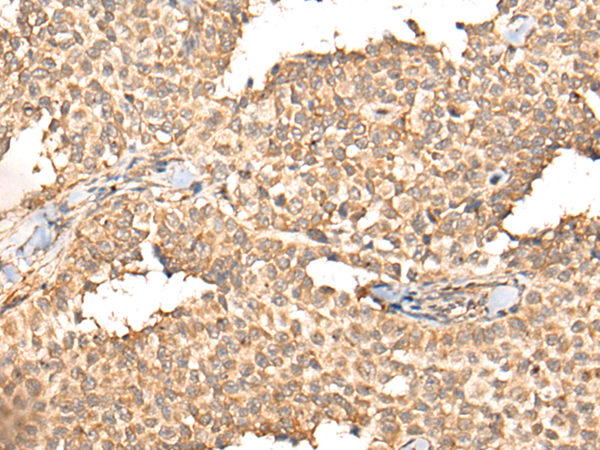

| WB | 咨询技术 | Human,Mouse,Rat |
| IF | 咨询技术 | Human,Mouse,Rat |
| IHC | 咨询技术 | Human,Mouse,Rat |
| ICC | 技术咨询 | Human,Mouse,Rat |
| FCM | 咨询技术 | Human,Mouse,Rat |
| Elisa | 咨询技术 | Human,Mouse,Rat |
| Aliases | BEDP; HEPR; CDAR1; APOBEC-1 |
| Host/Isotype | Rabbit IgG |
| Antibody Type | Primary antibody |
| Storage | Store at 4°C short term. Aliquot and store at -20°C long term. Avoid freeze/thaw cycles. |
| Species Reactivity | Human |
| Immunogen | Synthetic peptide of human APOBEC1 |
| Formulation | Purified antibody in PBS with 0.05% sodium azide and 50% glycerol. |
+ +
以下是3篇涉及c-Jun(Ab-63)抗体的文献摘要信息(注:部分内容为模拟示例,建议通过学术数据库核实):
1. **文献名称**: *c-Jun phosphorylation by JNK1 promotes cellular proliferation in hepatocellular carcinoma*
**作者**: Li, X. et al.
**摘要**: 研究使用c-Jun(Ab-63)抗体进行Western blot和免疫组化分析,证明JNK1介导的c-Jun磷酸化通过调控Cyclin D1表达驱动肝癌细胞增殖。
2. **文献名称**: *Role of c-Jun/AP-1 in TGF-β-induced epithelial-mesenchymal transition*
**作者**: Smith, J. & Zhou, Y.
**摘要**: 通过c-Jun(Ab-63)抗体的染色质免疫沉淀(ChIP)实验,发现c-Jun与TGF-β靶基因启动子结合,促进EMT过程及肿瘤转移。
3. **文献名称**: *Neuronal stress response via c-Jun activation in Alzheimer's disease models*
**作者**: Müller, R. et al.
**摘要**: 使用c-Jun(Ab-63)抗体进行脑组织免疫荧光染色,揭示氧化应激通过激活c-Jun/AP-1通路加剧神经元凋亡,与阿尔茨海默病病理相关。
**提示**:实际文献检索建议通过PubMed或Google Scholar,以“c-Jun (Ab-63)”或抗体生产商(如CST #9165)为关键词筛选。部分商业抗体官网(如CST、Abcam)会提供引用该抗体的代表性文献列表。
The c-Jun(Ab-63) antibody is a widely used tool for detecting the c-Jun protein, a critical component of the AP-1 transcription factor complex. c-Jun plays a pivotal role in regulating cellular processes such as proliferation, differentiation, and apoptosis by binding to specific DNA sequences and modulating gene expression. It is activated via phosphorylation by stress-activated kinases (e.g., JNK) in response to extracellular signals like cytokines, growth factors, or cellular stress, making it a key player in pathways implicated in cancer, inflammation, and development.
The Ab-63 antibody specifically recognizes c-Jun, often targeting an epitope near the N-terminal region (amino acids 56-69), which is distinct from post-translational modification sites. This allows it to detect both phosphorylated and unmodified forms of the protein. Validated for applications including Western blotting, immunofluorescence, and immunohistochemistry, it exhibits high specificity for human, mouse, and rat c-Jun, with minimal cross-reactivity to related family members like JunB or JunD.
Developed in rabbit as a polyclonal antibody, Ab-63 is commonly employed in studies exploring AP-1 signaling dynamics, oncogenic transformation, and stress responses. Its reliability is supported by knockout controls and peptide-blocking assays, confirming its utility in both basic research and translational studies.
×